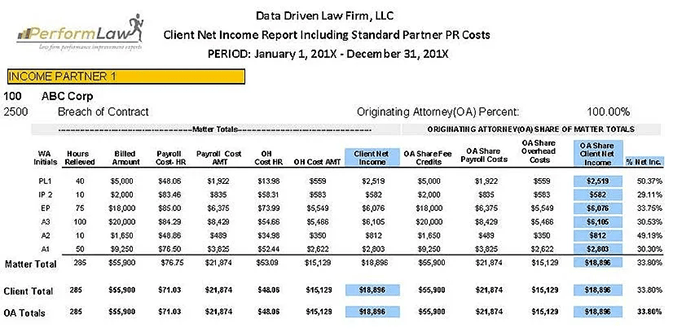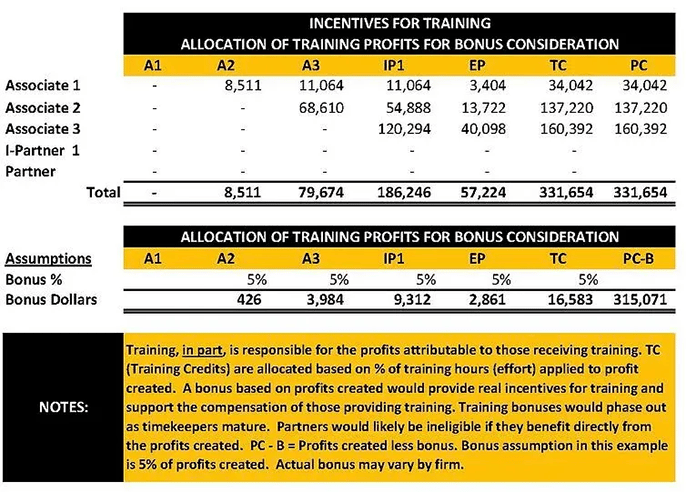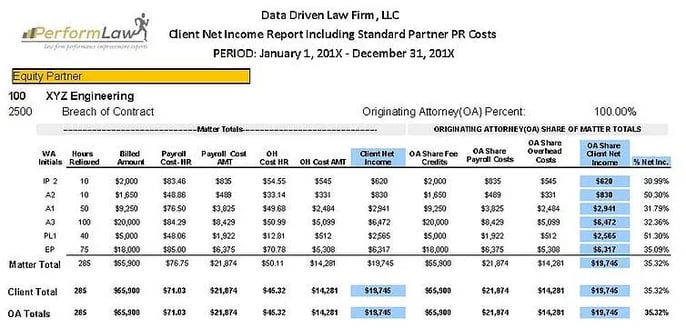Beyond the billable hour, there are additional ways in which associates can bring value to a firm. However, firms rarely consider these other areas of value in developing their associate compensation plans.
Four of the more quantifiable, non-production ways that associates can add value include:
- Originations
- Training
- Leveraging
- Recruiting profitable lawyers
This article will review these areas and how they can increase an associate's value to the firm. We will discuss how firms can measure and quantify an associate's performance in these areas for determining compensation.
Originations
Business origination value is evident - associates who bring in clients create income. While associate business development is commendable, many questions arise when the subject of compensation is brought into the conversation.
- Should the firm compensate associates for the clients they bring in?
- Should associates simply appreciate that client development will help them attain partnership admission?
These are fair questions, especially since associates work on other lawyers’ originations until they are self-supporting. Additionally, the marketing costs associated with obtaining a new client must be considered, especially since the partners underwrite these costs.
Among the firms that offer bonuses, we typically encounter rewards based on collected fees (5% or 10%). These firms believe that short-term business development bonuses will act as an incentive. A potential contradiction is that many of these same firms are unwilling to reduce billable expectations for business development efforts or even successes.
Regardless of incentive programs, we recommend associates consider business development as a strategic component of their career development to be balanced with the other elements essential to increasing value as a lawyer (competence, training, leveraging, reputation, etc.)
For firms inclined to compensate for business development, we prefer basing rewards on profitability contributed. If marketing costs are material, they can be netted against client profitability.
Consider the example below:

Reviewing this sample result indicates a fully costed profit of $18,896. If the firm were to pay a bonus of 10% of the gross collections, the bonus would be equivalent to 30% of the profitability (($55,908 * 10%)/$18,896), which would reduce the firm’s profit margin to 23%. Depending upon the firm’s acceptable margin ranges, a bonus of 10% of gross fees would likely not work. The range of bonuses based on profit contributed would depend on acceptable margin ranges.
There may also be concerns about the role of other bonus award programs potentially compensating the same result twice. For example, a production bonus on timekeeper profitability would include the profitability indicated in client profitability. As long as those costs are included in the calculation of client profitability or accounted for in the award percentage, this is a minor concern. In some instances, the bonus award is applied to all time, excluding the associate receiving the business development award.
Training Contributions
Younger associates spend most of their time being trained and do not provide any real training to other associates. More experienced associates, however, may make tangible training contributions.
- Should associates be given training bonuses or should they view these efforts as payback for the training they received?
- Training creates real value and adds profit on an expedited basis.
- Would compensating senior associates incent them to train junior associates better?
We believe it would.
Consider the following training bonus example:

Identifying training contributions using tracked training hours and applying them to profits created is a way to correlate training efforts with compensation directly. In this example, A2 was credited with 8,511 of A1’s profitability and awarded a 5% bonus for these efforts. A3 was credited with $11,064 of A1 Profit and 68,610 of A2’s profit and awarded a bonus of $3,984. The remaining training credits are calculated the same way. Actual bonus awards percentages may differ, but meaningful rewards get the best results.
Leveraging (managing and supporting the efficient workflow of others)
Although senior associates can help manage the work of junior associates and create profits, we believe that value added leveraging will more likely occur at the income or junior partner levels. Maintaining personal production would be required to be eligible for this type of bonus.
There may be a blurring of the line between training and supervision, but the important point is to recognize these contributions and reward them adequately. For example, compensating for workload management may eliminate the need for a separate training bonus.
In firms that compensate based on contributed profit, a portion of these profits may be allocated to those participating in managing the files. Again, we recommend paying on generated profit, but we have encountered bonus systems based on gross fees generated. For example, assume Equity Partner (EP) works on a matter with Income Partner (IP1). Further assume IP1 has materially participated in training and managing the associates and paralegals assigned to this file.
As an incentive, EP decides to award a bonus of 10% of the leverage profit on this matter to A3. In this instance, leverage profit would include profits on all timekeepers, excluding EP and A3’s time. The following report is useful to calculating the bonus:

In this instance, IP1’s bonus would be calculated as follows:
|
Total Profits |
$19,745 |
|
Less: |
|
|
EP Profit |
$6,317 |
|
A3’s Profit |
$6,472 |
|
Leverage profit (bonus base) |
$6,956 |
|
Bonus Percent |
10% |
|
Earned training and leverage bonus for this matter |
$696 |
The bonus on this one file may seem small, but repeat this process 5 or 10 times and the incentive is real.
Recruiting
Recruiting compensation can range from a flat or scaled bonus for the initial hire to compensating based on the profitability of the recruit. Flat bonuses are most common. Avoiding headhunter fees is the most common justification for bonus plans. Encouraging organic recruiting has the added benefit of supporting longevity – attorneys who bring their peers to the firm are less likely to leave. To the external world, lawyers that aggressively promote their firm send a strong positive about their environment.
The value added from recruiting a single attorney to fill a staffing need is reflected economically in timekeeper profitability. While a bonus based on individual profitability is feasible, it is simpler to establish set bonus amount and many firms are not comfortable sharing the elements of profitability at non-partner levels.
Recruiting laterals with business comes with a different set of economics and challenges. Firms not reaching their lateral recruiting goals, assuming their value proposition is adequate, may need to energize partners to recruit more aggressively. Additionally, non-partners and junior partners received no real benefit from attracting profitable laterals.
Senior partners, due to their ownership percentages, are more poised to enjoy the benefits of spreading fixed overhead among more attorneys. Most firms believe that it is incumbent upon general partners to recruit for the good of the firm.
While this is understandable, most partners do not actively recruit quality laterals. Instead, firms rely heavily on recruiters, who perform a necessary service, but organic recruits come with all of the intangible longevity benefits previously mentioned.
Firms that have quality profitability tools are in a position to create a profit-based bonus pool to reward lateral recruiting.
.webp?width=124&height=108&name=PerformLaw_Logo_Experts3%20(1).webp)

